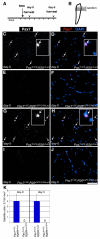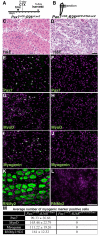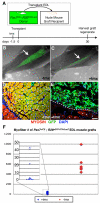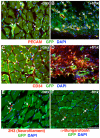An absolute requirement for Pax7-positive satellite cells in acute injury-induced skeletal muscle regeneration
- PMID: 21828092
- PMCID: PMC3152922
- DOI: 10.1242/dev.067595
An absolute requirement for Pax7-positive satellite cells in acute injury-induced skeletal muscle regeneration
Abstract
Skeletal muscle tissue provides mechanical force for locomotion of all vertebrate animals. It is prone to damage from acute physical trauma and physiological stress. To cope with this, it possesses a tremendous capacity for rapid and effective repair that is widely held to be accomplished by the satellite cells lying between the muscle fiber plasmalemma and the basement membrane. Cell transplantation and lineage-tracing studies have demonstrated that Pax7-expressing (Pax7(+)) satellite cells can repair damaged muscle tissue repeatedly after several bouts of acute injury. These findings provided evidence that Pax7(+) cells are muscle stem cells. However, stem cells from a variety of other origins are also reported to contribute to myofibers upon engraftment into muscles, questioning whether satellite cells are the only stem cell source for muscle regeneration. Here, we have engineered genetic ablation of Pax7(+) cells to test whether there is any significant contribution to muscle regeneration after acute injury from cells other than this source. We find that such elimination of Pax7(+) cells completely blocks regenerative myogenesis either following injury to the tibialis anterior (TA) muscle or after transplantation of extensor digitorum longus (EDL) muscles into nude mice. As Pax7 is specifically expressed in satellite cells, we conclude that they are essential for acute injury-induced muscle regeneration. It remains to be established whether there is any significant role for stem cells of other origins. The implications of our results for muscle stem cell-based therapy are discussed.
Figures





References
-
- Bigard A. X., Janmot C., Sanchez H., Serrurier B., Pollet S., d'Albis A. (1999). Changes in myosin heavy chain profile of mature regenerated muscle with endurance training in rat. Acta Physiol. Scand. 165, 185-192 - PubMed
-
- Bischoff R. (1975). Regeneration of single skeletal muscle fibers in vitro. Anat. Rec. 182, 215-235 - PubMed
-
- Collins C. A., Olsen I., Zammit P. S., Heslop L., Petrie A., Partridge T. A., Morgan J. E. (2005). Stem cell function, self-renewal, and behavioral heterogeneity of cells from the adult muscle satellite cell niche. Cell 122, 289-301 - PubMed
Publication types
MeSH terms
Substances
Grants and funding
LinkOut - more resources
Full Text Sources
Other Literature Sources
Molecular Biology Databases
Research Materials

